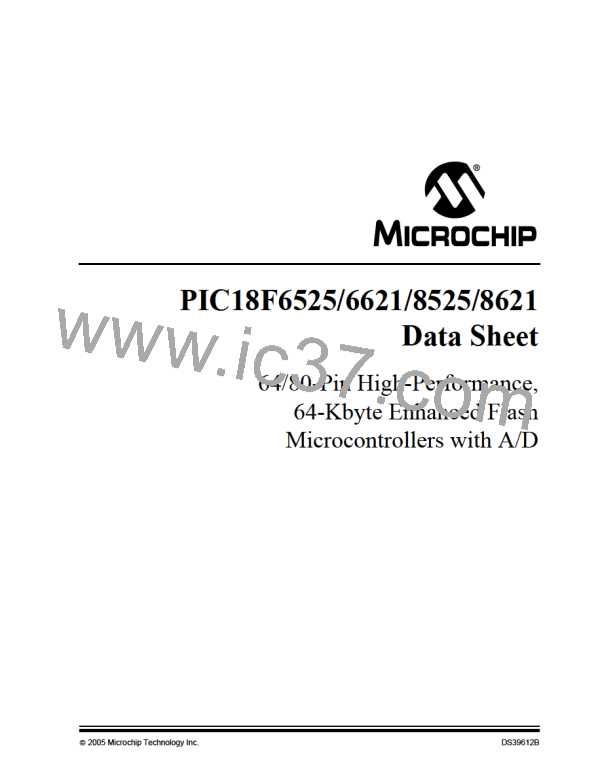PIC18F6525/6621/8525/8621
the routine which increments the seconds counter by
one; additional counters for minutes and hours are
incremented as the previous counter overflow.
12.6 Using Timer1 as a
Real-Time Clock
Adding an external LP oscillator to Timer1 (such as the
one described in Section 12.2 “Timer1 Oscillator”)
gives users the option to include RTC functionality to
their applications. This is accomplished with an
inexpensive watch crystal to provide an accurate time
base and several lines of application code to calculate
the time. When operating in Sleep mode and using a
battery or supercapacitor as a power source, it can
completely eliminate the need for a separate RTC
device and battery backup.
Since the register pair is 16 bits wide, counting up to
overflow the register directly from a 32.768 kHz clock
would take 2 seconds. To force the overflow at the
required one-second intervals, it is necessary to pre-
load it. The simplest method is to set the Most Signifi-
cant bit of TMR1H with a BSFinstruction. Note that the
TMR1L register is never preloaded or altered; doing so
may introduce cumulative error over many cycles.
For this method to be accurate, Timer1 must operate in
Asynchronous mode and the Timer1 overflow interrupt
must be enabled (PIE1<0> = 1), as shown in the
routine, RTCinit. The Timer1 oscillator must also be
enabled and running at all times.
The application code routine, RTCisr, shown in
Example 12-1, demonstrates a simple method to
increment a counter at one-second intervals using an
Interrupt Service Routine. Incrementing the TMR1
register pair to overflow, triggers the interrupt and calls
EXAMPLE 12-1:
IMPLEMENTING A REAL-TIME CLOCK USING A TIMER1 INTERRUPT SERVICE
RTCinit
MOVLW
MOVWF
CLRF
0x80
TMR1H
TMR1L
; Preload TMR1 register pair
; for 1 second overflow
MOVLW
MOVWF
CLRF
b’00001111’
T1CON
secs
; Configure for external clock,
; Asynchronous operation, external oscillator
; Initialize timekeeping registers
;
CLRF
mins
MOVLW
MOVWF
BSF
.12
hours
PIE1, TMR1IE
; Enable Timer1 interrupt
RETURN
RTCisr
BSF
BCF
INCF
MOVLW
TMR1H, 7
PIR1, TMR1IF
secs, F
.59
; Preload for 1 sec overflow
; Clear interrupt flag
; Increment seconds
; 60 seconds elapsed?
CPFSGT secs
RETURN
; No, done
CLRF
INCF
MOVLW
secs
mins, F
.59
; Clear seconds
; Increment minutes
; 60 minutes elapsed?
CPFSGT mins
RETURN
; No, done
CLRF
INCF
MOVLW
mins
hours, F
.23
; clear minutes
; Increment hours
; 24 hours elapsed?
CPFSGT hours
RETURN
; No, done
MOVLW
MOVWF
RETURN
.01
hours
; Reset hours to 1
; Done
DS39612B-page 138
2005 Microchip Technology Inc.

 MICROCHIP [ MICROCHIP ]
MICROCHIP [ MICROCHIP ]